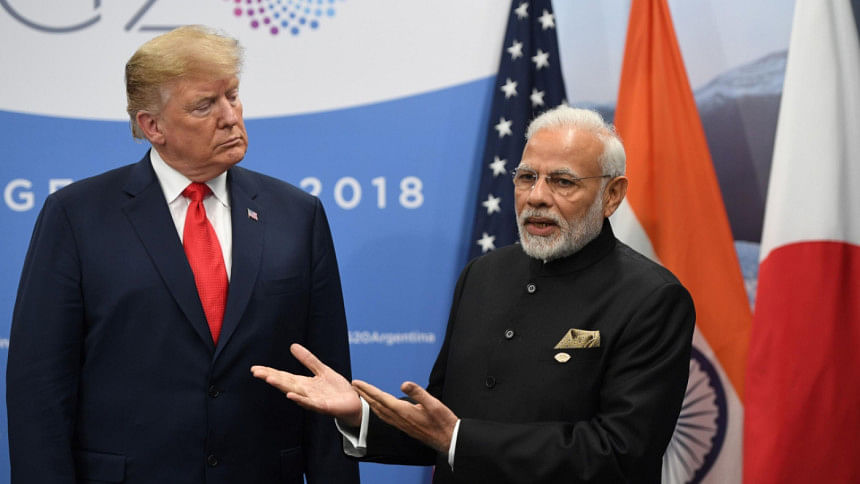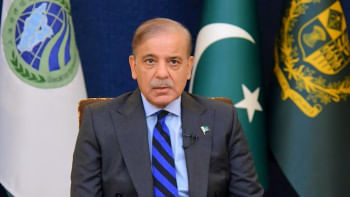India-US tariff tiff goes beyond trade

It has finally happened. The trade conflict between India and the United States has broken out as New Delhi ended its almost year-long wait for a negotiated settlement and came up with a retaliatory step imposing higher tariffs on import of 28 high-value agricultural items from the US with effect from June 16. It was in June last year that the US set off the conflict by hiking the duties on import of goods from India including steel and aluminium.
The delay in India's reciprocal measure is not difficult to understand. India wanted to give trade negotiations with the US a chance. But not only did that not happen, but what killed the prospects of a breakthrough was the announcement by President Donald Trump in March this year about the withdrawal of the Generalized System of Preferences (GSP), a special trade facility the US has given to nearly 120 developing countries, including India, permitting them to sell a portion of their goods in the US market free of import duty. India was the biggest beneficiary of the GSP which Trump terminated for India's refusal to lower tariff barrier to import of American medical devices, particularly stents, dairy products and Harley Davidson motorcycles. Under the GSP, India exported goods worth USD 6 billion to the US last year. Trump had often termed India the "tariff king."
In trade, the US is miffed about India imposing price caps on certain medical devices from the US for the benefit of poor patients in India. This has hit American multinationals like Abbot and Boston Scientific.
That the retaliatory tariff move by India was on the cards had been indicated by Commerce Minister Piyush Goyal the week before last when he hinted that New Delhi is not going to pursue a solution to the GSP withdrawal problem and is ready to move on without the trade concession from the US. Goyal said the discontinuation of the GSP was not a matter of life and death for Indian exporters. "India is now evolving and moving out of the crutches that we thought we needed to export. India is no more an underdeveloped or Least Developed Country that we will look at that kind of support. We believe we can be competitive in exports on our own strength," he said.
This is reflective of a bold new approach by India and Goyal's words are part of a new diplomatic lexicon in New Delhi in its dealing with the US for two main reasons: 1) India's economic heft makes it ready to stand up to the US without any rancour, and 2) India is prepared to be transactional in handling bilateral relations. Such a stance was waiting to be adopted by India for quite some time now, discarding the traditional rhetoric about shared values of democracy and freedom in conducting international relations. The US never carried any ideological baggage in its foreign policy and its only guiding principle was national interests. Why should India be bogged down by any ideology in pursuing its own interests? As the Indian commerce ministry had asserted in its reaction to the US decision to scrap the GSP for India: "We have significant development imperatives and concerns and our people also aspire for better standards of living."
India's initial refusal to hit back at the US with tariff hikes was apparently viewed by the US as a sign of itching for a compromise. India's retaliatory tariff measure can now alter the terms of trade engagement between India and the US. The two countries can now go to the negotiating table as equal partners, according to Biswajit Dhar, a professor of economics at Jawaharlal Nehru University. He said it was untenable that Washington would want greater market access in India on the one hand, and end the GSP facility on the other. While India's exports to the US amounted to USD 52.4 billion in the fiscal year 2019, imports stood at USD 35.5 billion.
India's clamping higher tariffs on American imports is expected to cast a shadow on the proposed meeting between Prime Minister Narendra Modi and Trump on the sidelines of the G20 Summit in Osaka, Japan, on June 28-29, and prior to that on the bilateral talks between Indian External Affairs Minister S Jaishankar and American Secretary of State Mike Pompeo, when the latter visits New Delhi on June 25-26. This would be the first meeting between Modi and Trump after the former assumed power as prime minister for a second consecutive term on May 30, following the Indian parliamentary elections, and the Jaishankar-Pompeo talks would be doing the spadework for the summit-level interaction.
The trade issue is likely to figure prominently in Modi-Trump talks in Osaka. Ahead of his travel to Osaka, the Indian prime minister articulated what Trump can expect to hear from him. In his speech at the Shanghai Cooperation Organization Summit in Bishkek, Kyrgyzstan, on June 13, Modi attacked unilateral trade protectionism saying it did not benefit anyone and highlighted the need for a rule-based global trading arrangement.
In trade, the US is miffed about India imposing price caps on certain medical devices from the US for the benefit of poor patients in India. This has hit American multinationals like Abbot and Boston Scientific. The US companies consider India a lucrative market, estimated at around USD 5 billion, for their medical devices. Analysts say the costly medical devices, particularly stents, may affect the flourishing medical tourism in India. Secondly, India's recent changes in e-commerce rules have raised the hackles of US giants Walmart and Amazon, which run India's top two online market places. The rule changes prevent the two behemoths from forcing sellers to bring products exclusively on their platforms. Thirdly, India's insistence on digital payment service providers storing data on Indian consumers on servers located in India, as protection against data breach, has become another bone of contention. The US considers the data localisation as discriminatory and trade-distorting. Analysts feel the US unhappiness about online trade rules change and data localisation has prompted the Trump administration to withdraw the GSP benefit to India.
However, to put the India-US tariff tiff in a proper perspective, one needs to take a much larger picture of the sticking points in bilateral relations beyond trade. True, India and the US have convergence of views about a rising China. The Trump administration's putting more and more heat on Pakistan on the issue of cross-border terrorism and prompting China to give up its veto on the designation of Jaish-e-Mohammed terror group founder Masud Azhar in the UN list of terrorists were welcomed in New Delhi. But there is a divergence of opinion between India and the US in some other areas. The US has indicated at a threat of sanctions on India if New Delhi goes ahead with the purchase of S-400 missile defence system from Russia and buys crude oil from American sanctions-hit Iran.
On the other hand, the US hopes to secure big defence deals with India estimated at USD 10 billion. These, according to Indian media reports, include 24 multi-role helicopters, 30 weaponised Sea Guardian drones and National Advanced Surface-to-Air Missiles to protect the national capital city of Delhi. On June 13, US Senators John Cornyn and Mark Warner moved an amendment to the American National Defence Authorization Act (NDAA) to include India along with NATO allies for sale of sensitive defence hardware. Obviously, Washington sees India as a lucrative market.
It remains to be seen how the India-US trade friction plays out and if it impacts other areas of cooperation in the coming months. It looks unlikely that Trump will go back on restoring the GSP status to India or roll back import duty hikes on Indian steel and aluminium ahead of the US presidential elections next year. India, for its part, must brace for switching over to transactional diplomacy with the US.
Pallab Bhattacharya is a special correspondent for The Daily Star.
Follow The Daily Star Opinion on Facebook for the latest opinions, commentaries and analyses by experts and professionals.
To contribute your article or letter to The Daily Star Opinion, see our guidelines for submission.

 For all latest news, follow The Daily Star's Google News channel.
For all latest news, follow The Daily Star's Google News channel. 



Comments